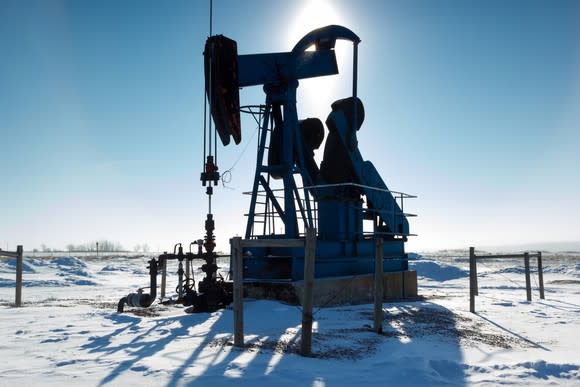Why Crescent Point Energy Crashed 38% in November
What happened
Shares of Crescent Point Energy (NYSE: CPG) plummeted 38.1% in November, according to data provided by S&P Global Market Intelligence. Driving the Canadian oil producer's downward spiral was a big drop in oil prices, especially the Canadian oil benchmark, as well as negative comments by one of the company's largest shareholders.
So what
Oil prices plunged in November, with the U.S. benchmark, WTI, falling 22%. Weighing on crude was the Trump administration's decision to grant waivers to key buyers of Iranian oil that enabled them to continue purchasing crude from that country even after the U.S. imposed new sanctions. That unexpected development quickly erased fears that there wouldn't be enough oil, replacing them with concerns that there would now be a glut.

Image source: Getty Images.
The drop in crude prices was even worse in Canada. Its oil benchmark, WSC, crashed to as low as $12 a barrel during the month, trading at a discount to WTI of more than $40 a barrel. That's much wider than the already-problematic $15-a-barrel discount due to that country's pipeline capacity shortage. With Canada's pipeline situation not expected to improve due to additional issues with both the Trans Mountain Pipeline expansion and TransCanada's (NYSE: TRP) Keystone XL pipeline, oil producers in the country are turning to rail while the province of Alberta issued a mandatory production cut for 2019.
This slump in oil prices weighed heavily on Crescent Point Energy last month, since it will likely affect that company's cash flow going forward. Also putting pressure on Crescent Point Energy was shareholder Cation Capital, which said that the company needs new leadership to lead a formal process to maximize its value. Cation said that the "ongoing value erosion" of Crescent Point Energy's stock price is due to a "clear failure of leadership and governance within the company." Though it's worth pointing out that the oil company installed a new CEO in September and has undertaken several initiatives to cut costs, and that it aims to sell more than 1 billion Canadian dollars ($750 million) in assets by the end of next year to reduce debt.
Now what
Crescent Point Energy got pulled under by oil prices last month, which is par for the course for an oil producer. Its decline was steeper than most because of its exposure to Canadian crude. While that price has come under tremendous pressure due to the country's pipeline problems, Alberta's recent decision to cut production should help ease some of the region's oil glut. The decision has already fueled a rally of more than 8% in Crescent Point's stock in December, which could continue in the coming months, especially if TransCanada is able to start building the crucial Keystone XL pipeline.
More From The Motley Fool
Matthew DiLallo has no position in any of the stocks mentioned. The Motley Fool has no position in any of the stocks mentioned. The Motley Fool has a disclosure policy.

 Yahoo Finance
Yahoo Finance 